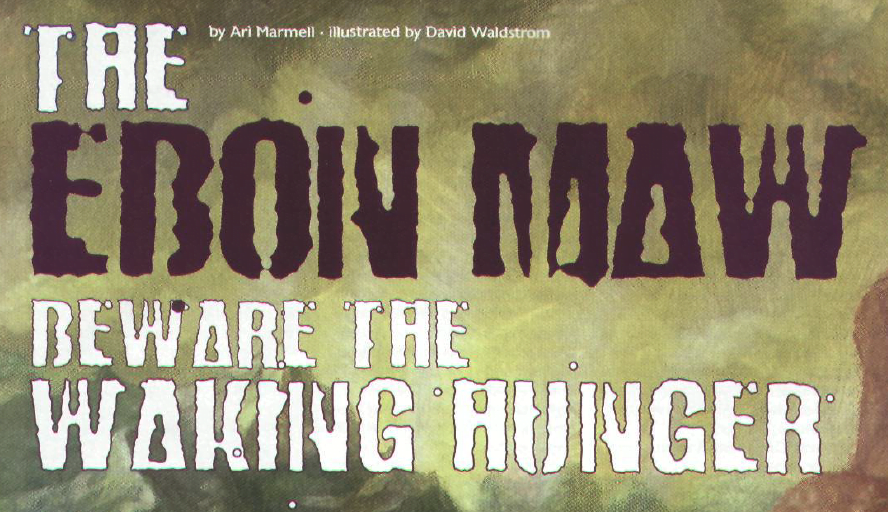As usual, Dragon featured a tie-in article for the Book of Exalted Deeds. However, “Holier Than Thou: Celestial Monster Classes, Part I” by Christopher Perkins doesn’t actually feature any lore. Rather, it’s just statistics and information for playing as some of the celestial “monsters” in that book, including asuras, bariaurs, hollyphants, leskylors (yay!), moon dogs, quesars, and—to everyone’s astonishment—rheks. As such, it’s one of those supplemental pieces that really feels like it should’ve been part of the original work. I have a tad bit of resentment for these things, as if you spent the money on the full book you should really be given the full swath of content, but oh well. Oddly enough, despite the title’s implications there would be no follow-up about other celestial monster classes. “Part I” is it, and this displays just how little support Wizards gave this release compared with most splatbooks.
In the same issue of the magazine (#311, October 2003), though, we were randomly gifted with a rather cool and frequently overlooked planar article, “The Ebon Maw” by Ari Marmell. Here, Marmell describes a new demon lord, the titular Maw, and with this caused me to question why it had been so long since one was last created. At this point we hadn’t seen any new ones since Gary Gygax was around dreaming them up for the Monster Manual II from first edition AD&D, and unlike with the archfiends of Hell there’s no reason to limit new ones. Wizards would take up this cause in the future with some extremely good splatbooks later in the edition, and meanwhile Paizo would also seemingly take this concept and run with it in their upcoming Demonomicon of Iggwilv series, but it’s possible neither of these would’ve occurred had Marmell’s contribution here not been so good.
The Ebon Maw’s proper name is Turaglas, labeled here as “the most primal of the demon princes,” though I would argue that by being in essence a gigantic blob made up of ever-hungry maws, he’s not too far removed from Juiblex or Zuggtmoy, who are also weirdo globules of muck. In any case, he barely seems a conscious entity and more a force of nature; not quite as ineffable as the Old Ones of Lovecraft, but certainly a different type of being from the typical demon lords. Demogorgon or Graz’zt have schemes and thoughts, whereas Turaglas only has hunger. It was this hunger that caused him some of his difficulties, as Turaglas was just as likely to eat allies as enemies. I think of him as a bit like Galactus from Marvel, almost an elemental force bent on destruction for reasons less immoral than amoral, though the article sure thinks of him as evil.
Following his escape into the Prime Material plane, Turaglas wrecked havoc there and somehow even founded a cult of followers. However, he was perhaps too noticeably successful in his endeavor to eat the entire world, and was stopped by a temporary alliance between Demogorgon and Orcus. The pair managed to send him into “the void between worlds” and imprison him there, which is a location previously thought of as the Astral Plane but, well, apparently it’s not anymore. Despite the other archfiends’ efforts to erase knowledge of Turaglas from the multiverse, a quasit tricked a mage into calling him back onto the Prime, and though he’s now weakened (slightly), he’s beginning to grow back into his true strength.
There’s more lore to Turaglas than I’m including here, which actually makes him one of the more written-about demon lords, as despite their ubiquity since the beginning of D&D the specifics of these individuals tends to get glossed over. The article covers the Ebon Maw’s entire cult structure, from beliefs to ranks to how they fit into various societies, and as such it seems rather easy to transport this to most any campaign. Marmell even includes new feats, magic items, spells, and even a clerical domain for his archfiend. And while that may seem off given that demon lords aren’t actually gods and as such are unable to grant spells, he simply says that this isn’t the case for Turaglas, which is something I support fully, as this distinction always annoyed me.
Although the Ebon Maw is not a deity, his clerics receive the full range of divine spells and abilities available to others of their class. Whether Turaglas has some means of granting such power despite his nondivine status, or is himself the servant or avatar of some great evil, none can say.
I would happily steal this explanation myself for pretty much all archfiends or other demi-Powers, and I’m glad that Paizo/Wizards allowed this workaround here. Oddly, this seems like it would make him the most powerful of all the archfiends short of perhaps Asmodeus himself, but the inconsistency here seems hardly acknowledged elsewhere.
Less interesting to me are the statistics for Turaglas himself, but fortunately he’s not the only new creature included. His minions, the turagathshenee, also make an appearance here, looking a bit like the Pale Man from Pan’s Laybrinth. Like their lord, the turagathshnee are also about eating creatures, to the point that their gullets are “partially extradimensional space,” and thus they can swallow opponents even their own size.
In all, it’s an extremely thorough write-up of a new demon lord, both an excellent read and a thoughtful bit of world-building for the Abyss. Apparently I wasn’t the only one who appreciated this effort, either, as Turaglas continued showing up in the game even into fourth edition, and as such remains one of the better-known and covered demon lords apart from Gygax’s originals.




